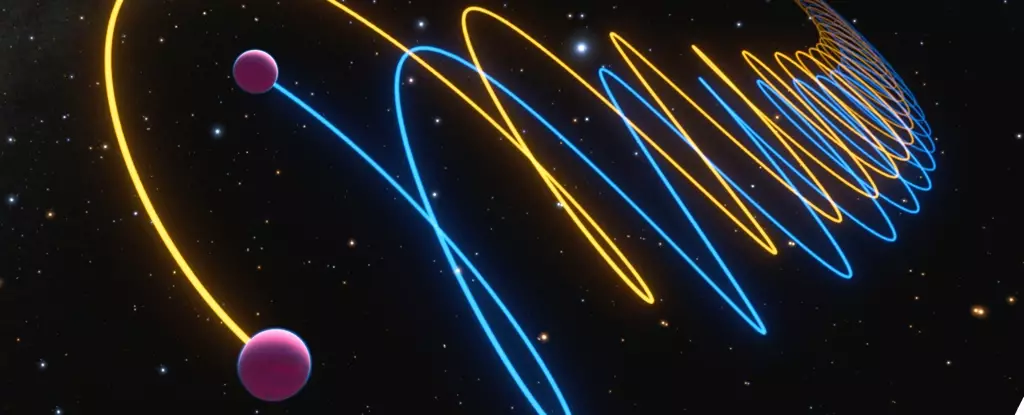In 1995, a remarkable revelation in the field of astronomy emerged from the sterile walls of Caltech’s Palomar Observatory. Researchers first set their eyes on Gliese 229 B, a brown dwarf orbiting the red dwarf star Gliese 229, approximately 19 light-years away from Earth. This finding was groundbreaking, but as investigations progressed, the luminous behavior of Gliese 229 B led to an enduring mystery. With a mass 70 times that of Jupiter, one would expect it to exhibit a much greater brightness in the cosmic tapestry; however, it remained disappointingly dim. The intrigue around this celestial body persisted for almost three decades, confounding many in the astronomical community.
The mystery surrounding Gliese 229 B has finally been unraveled by a dedicated team of international astronomers led by Jerry W. Xuan from Caltech. Their collaborative effort, which published its findings in the esteemed journal Nature, posits that this enigmatic brown dwarf is not a singular entity but instead comprises a binary system—two closely orbiting brown dwarfs, aptly named Gliese 229 Ba and Gliese 229 Bb.
Xuan’s team didn’t just stumble upon this revelation; it was the result of meticulous research that included an array of sophisticated observational techniques. Utilizing the GRAVITY interferometer at the European Southern Observatory’s Very Large Telescope, they were able to resolve the two brown dwarfs for the first time. Their investigative process included analyzing the spectral signatures distinct to each dwarf, giving credence to their hypothesis regarding the dual nature of Gliese 229 B.
Particularly noteworthy is that this discovery aligns the observed brightness of Gliese 229 B with what astronomers would expect from two brown dwarfs of approximately 38 and 34 Jupiter masses. The binary system’s orbital characteristics—having a period of 12 days and an orbital separation roughly equivalent to 16 times the distance between Earth and the Moon—add further layers of complexity to our understanding of these stellar objects.
The initial observatory findings in the mid-90s marked the beginning of a cottage industry among astrophysicists and astronomers eager to find additional brown dwarfs in the cosmos. Gliese 229 B quickly became a poster child for this newly defined class of celestial objects, bridging the gap between gas giants and true stars. The insights provided by researchers, such as Rebecca Oppenheimer and Shri Kulkarni—who were part of the original discovery team—have shaped our understanding of what constitutes a brown dwarf.
What is particularly striking is how these developments shift our perception of cosmic structures. Until now, the dimness of Gliese 229 B presented a tension between its theorized mass and luminosity. With the verification of its binary status, scientists have not only clarified this ambiguity but unlocked new areas for inquiry into the formation of brown dwarfs.
The implications of these findings are profound. The absence of light despite a supposed significant mass led astronomers to consider that Gliese 229 B was a binary object all along. This observation stirs intriguing questions regarding how brown dwarf pairs like Gliese 229 B form. Some hypotheses suggest that such systems may arise within a star’s protoplanetary disk, likely breaking off into two gravitationally-bound entities through close encounters.
As astronomers like Xuan and his colleagues continue to explore these dynamics, they have set their sights on identifying additional brown dwarf binaries within our universe. Anticipated advancements utilizing next-gen telescopes at institutions like the Keck Observatory aim to enhance our observational prowess.
In this blossoming field of research, we are reminded of how dynamic and unpredictable our universe is. New observational instruments will likely reveal more pairs orbiting each other and lead to an expanded inventory of substellar objects.
The unraveling of Gliese 229 B’s dual identity is an exciting development in the domain of astrophysics. Oppenheimer’s assertion reflects the wonderment that accompanies such a momentous discovery—if we had brown dwarfs like Gliese 229 B in our solar system, they would undoubtedly evoke awe and curiosity. This dual existence serves as a narrative reminder of the complexity inherent in celestial mechanics, serving as a testament to human inquiry into our universe.
Ultimately, this discovery not only challenges our current understanding of brown dwarfs but also beckons more questions, inviting future research into these enigmatic, substellar entities. With astronomers poised at the forefront of discovery, the cosmos may soon reveal even more of its secrets.


Leave a Reply